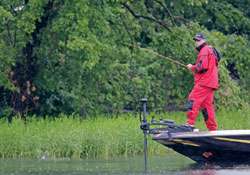
Fall bass fishing can be tough at times. With the fish caught in transition between late summer locations and their eventual winter haunts, where do you start fishing and what do you throw?We asked Bassmaster Elite Series pro Russ Lane for some answers.”Replacing the usual deep diving crankbait, jig or topwater plug with a spinnerbait will jar bass out of their summer doldrums,” said Lane. “Basically, I fish four types of places with four techniques.”
Deep breaks and ledges
Lane switches to a heavy spinnerbait when the deep crankbait bite disappears from the ledges. His first choice is a 1-ounce Vicious Big Daddy with twin willowleaf blades, a No. 4 and a No. 4 1/2. It’s made for a slow roll presentation.
“I work this bait down along drops and ledges, in the 10- to 15-foot range as fast as I can while still keeping contact with the bottom. The willowleaf blades help keep it down.Colorado blades give the bait too much lift. A good fluorocarbon line helps, too.Fluorocarbon is heavy and dense so it sinks quickly. I use 15-pound-test Vicious Fluorocarbon.”
Current
Late season bass are attracted to current. Generally, moving water is cooler and carries more dissolved oxygen. Lane doesn’t worry about structure or cover. In his opinion, the current itself will hold bass.
“In moderate current, I like a 3/4-ounce spinnerbait with a single No. 4 willowleaf blade and 20-pound Ultimate copolymer line if my casts are short,” he said. “But if the current is strong or if I’m making long casts, I switch to a 1-ounce spinnerbait and fish with 17-pound fluorocarbon.
“With short casts you need a little give. But with long casts, the current will create a bow in your line that gives you the same thing. You want one or the other but not both.”
Creeks
As the days become shorter and as the water temperature cools, forage species such as threadfin shad move into creeks. Lane said the bass follow them.
“Late in the year when I’m fishing in the back of a creek or large inflow, I often throw a 3/8- or 1/2-ounce spinnerbait dressed with a No. 2 Colorado blade and a No. 4 1/2 willowleaf blade. I like to make long casts with 20-pound copolymer and swim the bait around, through and into any wood I can find — big or little,” he said. “This is shallow fishing. More than 3 feet of water is probably too deep. And don’t forget that bass are wary creatures when they’re shallow. Any noise or commotion will run the fish off, and the entire area will be ruined.”
Topwater lairs
In areas where you might expect a topwater pattern, Lane switches to a spinnerbait.
“For some reason, bass don’t seem to want to break the surface of the water at this time. When that happens, wake a spinnerbait just under the surface. Pick places where you were throwing a popper or small walking stick. The idea is to be fast and quick but subtle. Never break the water’s surface,” he advised. “Generally, a lighter weight body, double willowleaf blades [No. 4 or 5], a grub as a trailer and 20-pound copolymer line make a good ‘waking’ combination. That blend will let you work the spinnerbait fast but still keep it just under the surface.”
Lane is not particular about color.
“I stick to the basics — light colors for clear water and dark colors for stained water. I might adjust those a little depending on the ambient light conditions. Early fall spinnerbait fishing is about showing bass something different, not tricking them with fancy, exotic colors.”
| |
For more great stories and the latest bass fishing news, subscribe to BASS Times. Call 877-BASS-USA to order today. |




